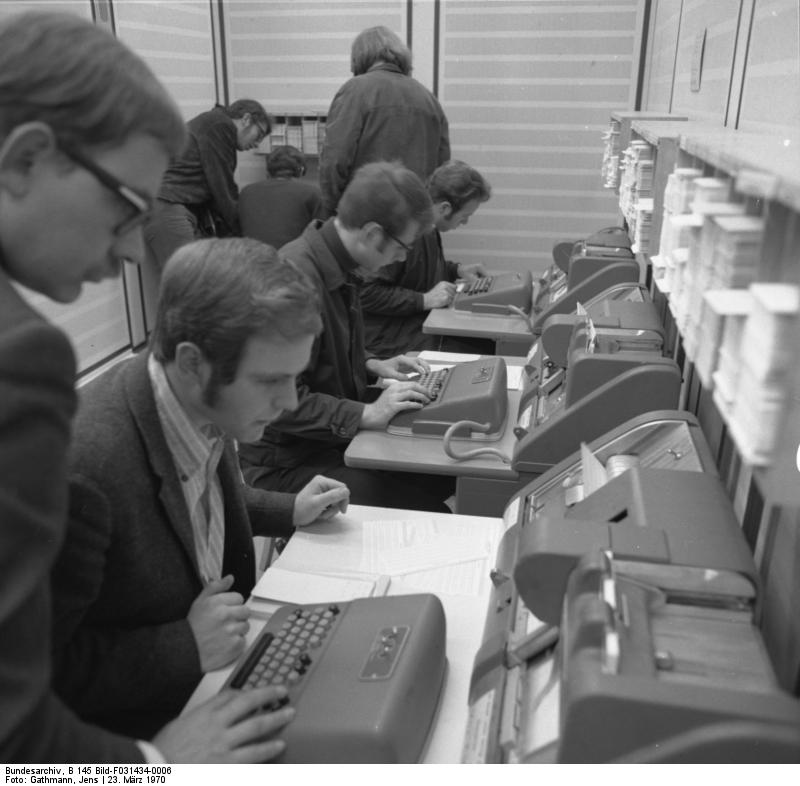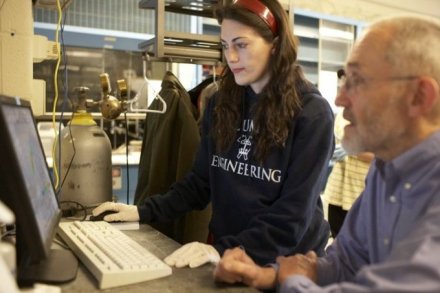
Image via Columbia University
How engineers learn in the 21st century is drastically different from how information was acquired back in the day. In the past, limited access to basic computers, specialized software, or advanced technology prevented engineers from acquiring information efficiently and through a tech-based learning process. Just think about how far military technology has come. Beowulf-esque chain mail-adorned troops once flocked into battle on horseback, equipped with nothing but swords and bludgeons. With modern technology and recent advancements, battle tactics have turned to drones, GPS tracking software, communication devices, and computerized weaponry to gain the upper hand in combat. These gadgets practically fight wars for these troops. Although primal forms of fighting worked, these early members of the military did not develop the proper technology for advanced battle tactic opportunities. When engineers-in-training previously learned, they had their own battle to fight in regard to how they absorbed all proper information and data. With much duress and determination, engineers were required to study enormous amounts of information, without much technological assistance, in order to learn and thrive in the industrial world. Nowadays, engineers have astounding access to the technology that has presented itself to the forefront, ready to help the next generation of engineers prepare for the future.
Ed Tory attended NYU’s Polytechnic Institute in the 1970s, studying Aerospace/Astro Engineering and Mathematics. While Tory was still in high school in the 1970s, he began using slide rulers. When reflecting back on his high school days, he stated, “I made it my business to be one of the only kids who could skillfully use a slide ruler. Teachers saw my potential in the engineering field.” He eventually graduated to using calculators and computers as technology moved forth and he progressed with his studies.
While learning at NYU’s Polytechnic Institute, he would study engineering textbooks for hours in the library, memorizing all sorts of equations and formulas, determined to eventually work with the best in the business. During Tory’s undergraduate career, he took a variety of engineering and aerospace courses; the seminars he attended incorporated mechanics classes, modern physics, thermodynamics, mechanics of materials, propulsion, history of science and technology, and computer methods of aerodynamics, just to name a few. Ed Tory received both his B.S. and M.S. from NYU’s Polytechnic Institute.
As part of his interdisciplinary studies during graduate school, Tory practiced at NYU’s division of the Courant Institute of Mathematics. He performed practical experiments, and learned to use punch card computers. He stated, “You’d walk around with this huge box of cards to insert into the computer and read the data. Around 50 pounds of cards would account for one program. These punch cards were some of the first versions of software ever created.” Tory mastered the use of the punch card computer very quickly.

Image of a punch card computer, just like the one Ed Tory used
Tory looked at computers like mathematical equations that needed to be solved, requiring answers. He developed and sharpened his computer skills, becoming proficient in many applications of engineering including UNIX shell programming, FORTRAN, AMDAHL, and DBMS/DBQ. Since Tory’s zeal for learning was so great, one of his professors invited him to work in the NYU Aerospace Laboratory as a research scientist and mathematician. Through this real world apprenticeship, Tory honed his skills in developing computer programs for associating theoretical research with experimental laboratory results. He learned how to use 6600 and IBM 360/270 computers, developing and using programs for theoretical solutions that were studied in the lab. Tory stated, “I compared results and interpreted all theoretical and experimental findings. I gained much experience with laboratory devices, including hotwire anemometers, oscilloscopes, digital recording devices, photography uses, and special techniques for visualizing details in experiments.” Back then, it was crucial to learn how to use analog transducers, digital processing of data as well as data reduction, correlation, interpretation, and report writing. “My studies at NYU helped me with these skills, many of them I memorized from the pages of a textbook,” said Tory.
As an engineer, Tory believes that experiential learning suited him best, and acquired special techniques and skill sets from each job he took on. From 1977 to 1985, Tory was contracted by NASA to work for Martin Marietta Corp. at the Kennedy Space Center (KSC) in Florida as a senior analyst and aerospace engineer. He enhanced his method for writing flight software routines in FORTRAN, helping with the Vehicle Assembly Building (VAB), Launch Control Center (LCC), and Launch Complex. As a member of the KSC, he was the recipient of a NASA achievement award and published various papers in NASA’s technical reports. All of the hands-on experience he received at NYU through his apprenticeship directly helped him with this endeavor.
Following the Challenger space shuttle accident in 1986, Tory was appointed by the President to join the NASA Investigation Commission. He worked alongside an adeptly skilled team at NASA’s Vandenberg Air Force Base in Lompoe, CA, actively participating as an analyst for the space shuttle accident’s review team. Tory and his associates worked together in an effort to figure out why the spacecraft crashed. Through Tory’s perseverance and diligence, he pursued a successful engineering career.
Sorock Kim, a modern civil engineer, received her bachelor’s degree from NYU last year, and is currently studying for her master's of science. Various techniques assisted Kim throughout her academic career. In regard to current learning techniques, Kim relied on computerized classroom tools for a bolstered approach on practicing engineering. She specified, “A lot of engineering practices, especially for professionals, are now performed as computer-aided engineering. Software that designs, models, and analyzes finite elements has changed engineering drastically. Engineering schools nowadays like to focus on not only theoretical engineering, but also practical and field engineering.”
Similarly to Tory, Kim knew that hands-on assignments furthered her potential, and would thus help her later with her career path. “Many degree curriculums and class syllabi for engineering are now designed to prepare students for real world-like works by assigning group or individual real-world-like project assignments,” she remarked. Kim’s program at NYU allowed her to develop an innovative intellectual tool belt both inside labs and outside of the classroom. Active, real life applications of engineering knowledge allow “students to learn more, both in quality and quantity, and also prepare them to become more successful as professional engineers.

Image via Columbia University
From recent technological advancements, Tory did not have access to more modern learning tools because they were not yet invented. There are infinite teaching tools readily available for rising engineers, like Kim, to use. She explained, “Instead of having limitations on teaching materials to text books or hand-outs, professors can now demonstrate the lessons using websites, videos, computer programs, or documents of large volume with computerized classroom systems (computer-based instructional systems).”
In order for engineers to be successful, one must master extraordinary interpersonal skills, since teams are compiled in this trade. The group work that Kim performed while at NYU definitely prepared her when working with “multiple professionals from different fields and backgrounds [who] inter-depend on each other and collaborate for large-scale engineering projects.”
Currently, Kim is working as a CAE consultant. She commented, “As a researcher and a design engineer intern in the past, I used the programs that I had learned in school already. My past experiences with other programs have helped me adapt quickly to newer programs.”
The tech world is in a constant state of flux. As technology advances each day, more techniques for engineers to learn and practices their trade will eventually rise, and engineers will become incresingly adept as the years roll on toward a bright future.
Advertisement









